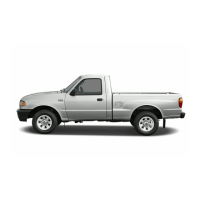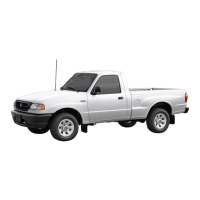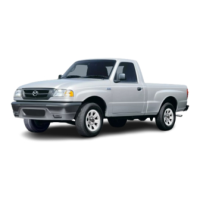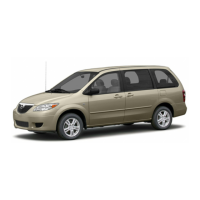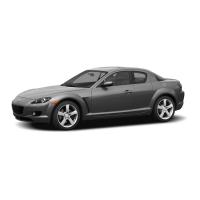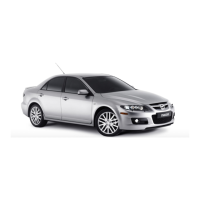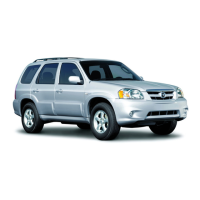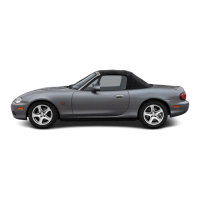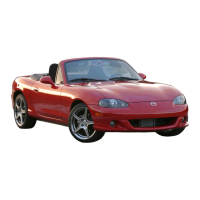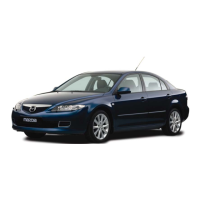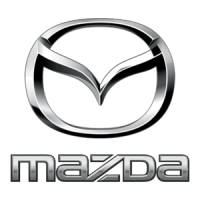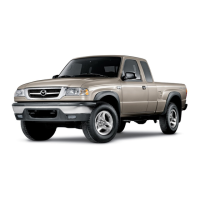
Do you have a question about the Mazda 2005 B2300 Truck and is the answer not in the manual?
| Brand | Mazda |
|---|---|
| Model | 2005 B2300 Truck |
| Category | Automobile |
| Language | English |
Details about the computer's ability to record vehicle data, including restraint system usage and performance.
Important safety advice regarding electronic controls, supplemental restraint systems, and child seat placement.
Highlights the higher rollover rate of utility vehicles and the importance of careful operation.
Explains various symbols that may appear on the vehicle's interior and exterior.
Alerts drivers to potential vehicle conditions and explains warning light functions.
Illuminates when the fuel cap is not properly installed, potentially affecting the Check Engine light.
Indicates low brake fluid or a failure in the brake proportioning system.
Informs about the ABS light status and when system servicing is required.
Indicates if the SRS system is functioning properly; illuminates if there is a malfunction.
Reminds occupants to fasten their safety belts and may sound a chime.
Illuminates when the battery is not charging properly.
Indicates when oil pressure falls below the normal range.
Illuminates when the engine coolant temperature is high.
Illuminates when the fuel level in the tank is at or near empty.
Illuminates when any door is open with the ignition in the ON position.
Indicates when the overdrive function has been turned off.
Illuminates when four-wheel drive low is engaged.
Illuminates when four-wheel drive high is engaged.
Illuminates when the speed control is engaged.
Illuminates when the turn signal or hazard lights are turned on.
Illuminates when the high beam headlamps are turned on.
Sounds when the key is left in the ignition and the driver's door is opened.
Sounds when headlamps/parking lamps are on, ignition is off, and driver's door is opened.
Sounds when any door is opened or not fully closed.
Explains the function of the speedometer, engine coolant temperature gauge, and odometer.
Registers the miles (kilometers) of individual journeys and how to reset it.
Indicates engine speed in revolutions per minute and warns against continuous high RPM.
Indicates fuel level and shows the location of the fuel filler door.
Details on operating the AM/FM stereo, including band selection, clock setting, and audio adjustments.
Instructions for using the AM/FM tuner, memory presets, SEEK, and ON/OFF/Volume controls.
Procedure for ejecting a CD from the player.
How to set the clock, including selecting hours and minutes.
Function to mute or unmute the playing media.
Explains how to use the MENU for various modes like Autoset, Bass, Treble, Balance, and Fade.
Operation for manually tuning radio frequency or selecting menu settings.
How to play tracks on a CD or MP3 in random order.
Function to repeat the current CD or MP3 track.
How to manually advance in a CD track or fast forward tape.
How to manually reverse in a CD track or rewind tape.
Instructions for setting and recalling radio stations.
How to access the next/previous strong station or track.
Function to scan available stations or tracks.
How to select AM/FM1/FM2 frequency bands.
Controls for turning the system on/off and adjusting volume.
Instructions for inserting CDs into the unit.
Instructions for inserting cassettes.
Operation details for the multi-disc CD/MP3 audio system.
Explains fan speed, temperature, and air flow selections for the heater system.
Tips for reducing fogging, humidity, and ensuring proper air flow.
Steps to improve visibility by directing airflow to side windows.
Details on fan speed, temperature, and air flow for manual HVAC controls.
Describes the functions of the headlamp control knob: off, parking lamps, and headlamps.
How to turn foglamps on and off, and their limitations with high beams.
Information on activating DRLs and a warning about their limitations.
How to activate and deactivate high beam headlamps.
How to use the flash-to-pass feature for headlamps.
Adjusting the brightness of the instrument panel and switch lighting.
Explains headlamp aiming procedures and when to consult a technician.
How to activate the left and right turn signals.
Information on replacement bulbs, including trade numbers for exterior and interior lighting.
Instructions for checking and using the correct bulbs for exterior lighting.
Guidance on checking and replacing interior bulbs.
Detailed procedure for replacing headlamp bulbs, including warnings.
Step-by-step instructions for replacing front side marker bulbs.
Procedure for replacing bulbs in the tail lamp assembly.
Instructions and warnings for replacing fog lamp bulbs.
Procedure for removing and installing the high-mount brake lamp assembly.
Instructions for locating and replacing license plate lamp bulbs.
Operation of the windshield wiper and washer controls.
How to clean and check wiper blades for wear and effectiveness.
Step-by-step instructions for replacing wiper blades.
Procedure for adjusting the steering wheel, with a warning about moving vehicle.
Information on power outlet usage, limitations, and fuse ratings.
Instructions for operating power windows and safety warnings.
How to operate the driver's window with a one-touch function.
Operation of the auto-dimming mirror and sensor precautions.
Information on compass accuracy, potential interference, and calibration.
How to display compass direction and temperature on the mirror.
Procedure to determine and set the correct compass zone.
Instructions for adjusting and folding power mirrors.
Guidance on folding side mirrors for narrow spaces.
Information on using speed control, its limitations, and warnings.
Step-by-step guide for setting the speed control.
Methods for disengaging the speed control system.
How to resume a previously set speed using the RES control.
Three methods for increasing speed while speed control is active.
Three methods for reducing speed while speed control is active.
Three ways to turn off the speed control system.
Explanation of overdrive function and how to activate/deactivate it.
Features of the center console, including storage and cupholders.
Instructions for extending, stowing, and removing the bed extender.
Information on key operation, replacement, and carrying a spare key.
How to use the power door lock control to lock or unlock doors.
Details on FCC compliance, operating range, and system features.
Procedure to unlock the driver's door and all doors using the remote.
How to lock doors using the remote, with park lamp confirmation.
How to activate the vehicle's panic alarm.
Instructions for replacing the battery in the remote entry transmitter.
Options for replacing lost or obtaining additional remote entry transmitters.
Step-by-step procedure for reprogramming remote entry transmitters.
How interior lamps illuminate with the remote entry system and when they turn off.
Adjusting the front manual seat and seatback, with safety warnings.
Accessing storage, detaching cupholders, and re-attaching them.
How to adjust lumbar support firmness for comfort.
How to access the rear area of the cab by moving the front seat.
Instructions for opening, stowing, and warnings about child seats in rear seats.
Precautions for safety restraints, including seatback position and child restraint usage.
How to insert and unfasten the seat belt tongue and buckle.
Describes the safety belt's energy management feature for injury reduction.
Explains the normal retractor mode and locking response to vehicle movement.
How to use the automatic locking mode for child safety seats.
Guidance on when to use the automatic locking mode for child seats.
Steps to engage the automatic locking mode for child safety seats.
Procedure to disengage the automatic locking mode.
Explains the function of safety belt pretensioners and when they must be replaced.
How to adjust the shoulder belt height for proper fit and safety.
Information that the lap belt does not adjust automatically.
Information on using safety belt extension assemblies if the belt is too short.
Explains the function of the safety belt warning light and chime.
Description of the BeltMinder feature for supplemental safety belt reminders.
Explains how the BeltMinder is disabled for a single ignition cycle.
Procedure for deactivating or activating the BeltMinder feature.
Detailed steps to activate or deactivate the BeltMinder.
Instructions for inspecting safety belt systems for proper function and damage.
General precautions for the supplemental restraint system (SRS).
Key safety precautions related to air bag deployment and usage.
Important safety information regarding children and air bags.
Guidance on restraining children using safety seats and belts.
Explanation of how the air bag SRS system activates based on deceleration.
Components of the Supplemental Restraint System (SRS).
How to check if the SRS system is operational using readiness lights and tones.
Procedures for the proper disposal of air bags and related components.
Information about the passenger air bag ON/OFF switch and its proper use.
Step-by-step instructions for turning the passenger air bag off.
Procedure for turning the passenger air bag back on.
Conditions under which Transport Canada permits airbag cut-off switch installation.
Key precautions for using child restraint systems, including legal requirements.
Guidance on using safety belts for children who have outgrown child safety seats.
Information on when children should use booster seats and types of booster seats.
Criteria for determining when a child needs to use a booster seat.
Description of backless and high-backed booster seat types.
Explains why shoulder belts are important with boosters and warnings about misuse.
Guidance for selecting and installing child and infant safety seats.
How to properly select and install child safety seats.
Steps for installing a child safety seat, including buckle usage and locking modes.
Procedure for installing child seats using vehicle seat belts.
Information on locating and attaching tether straps for child safety seats.
How to use LATCH system for child seat installation.
Highlights differences in handling and rollover risk for utility vehicles and trucks.
Describes characteristics like higher ground clearance and shorter wheelbase of SUVs/trucks.
Explains the function of 4WD/AWD systems for improved traction.
Compares SUVs/trucks to passenger cars regarding height, carrying capacity, and maneuverability.
Explanation of tire quality grades: Treadwear, Traction, and Temperature.
Defines the treadwear grade as a comparative rating of tire wear.
Describes traction grades representing the tire's ability to stop on wet pavement.
Defines temperature grades for tire heat resistance and dissipation.
General information on tire maintenance for maximum benefit and service life.
Defines terms related to tires, including TIN, inflation pressure, and tire parts.
Importance of proper tire inflation and procedures for inspection and inflation.
How to inspect tire treads and sidewalls for wear and damage.
Guidance on checking tire pressure with a gauge and recommended pressures.
Warnings about the dangers of under-inflated tires, including loss of control.
Explains maximum tire pressure vs. recommended cold inflation pressure.
Instructions for checking tire pressure, emphasizing cool tires.
Requirements for replacing tires and wheels, emphasizing using Mazda-approved parts.
Guidelines for changing a flat tire safely.
Information about temporary spare tires and their limitations.
Step-by-step instructions for changing a tire, including warnings.
Instructions for properly stowing the flat tire and spare tire.
Specifies the torque for wheel lug nuts and when to retighten them.
Explanation of information found on tire sidewalls, including DOT number and tire size.
Details on tire size, load index, and speed rating designations.
Official tire quality grades as required by the DOT.
Explanation of information specific to "T" type temporary spare tires.
Where to find the tire inflation pressure label on the vehicle.
Importance of vehicle maintenance for tire wear and abnormality.
How to inspect tire tread for wear, damage, and indicators for replacement.
Driving habits that affect tire mileage and safety.
Precautions for flat tires on the highway and handling suspected damage.
Importance of alignment and balancing to prevent tire wear and vibration.
Benefits of tire rotation for even wear, performance, and tire life.
Guidelines and warnings for using snow tires and chains.
Guidance on proper vehicle loading to stay within design ratings.
Definition of Base Curb Weight for vehicle loading calculations.
Definition of Vehicle Curb Weight, including aftermarket equipment.
Definition of Cargo Weight, including cargo and optional equipment.
Definition of Gross Axle Weight and its components.
Definition of Gross Axle Weight Rating and its location.
Calculations to determine available cargo and luggage load capacity.
Important information regarding safe operation and handling of loaded vehicles.
Guidance on towing capacity, trailer weight limits, and component inspection.
Towing specifications for 4x2 models with manual transmission.
Towing specifications for 4x4 models with manual transmission.
Towing specifications for 4x2 models with automatic transmission.
Towing specifications for 4x4 models with automatic transmission.
Ensuring proper equipment and attachment for towing a trailer.
Types of hitches recommended for towing trailers.
Instructions for connecting trailer safety chains.
Information on trailer brake systems and specifications.
Ensuring trailer lamps (running, brake, turn, hazard) are working.
Information on the optional step bumper's hitch capacity and limitations.
Location of the trailer tow connector and its function.
Tips for driving with a trailer, including speed control and gear selection.
Recommendations for more frequent service intervals after towing.
Tips for practice, stopping distance, tongue weight, and hitch checks.
Guidelines for launching/retrieving boats, avoiding water entry into vehicle components.
Guidelines for recreational towing to ensure transmission is not damaged.
Guidelines for recreational towing of vehicles with manual transmission.
Guidelines for recreational towing of vehicles with automatic transmission.
Note that pickup is not recommended for slide-in camper bodies.
Explains ignition positions and starting the engine.
Describes ACCESSORY, LOCK, OFF, ON, and START positions.
Information on engine starting control and meeting Canadian standards.
Checks required before starting a vehicle with an automatic transmission.
Checks required before starting a vehicle with a manual transmission.
Ensuring dashboard lights illuminate briefly upon ignition.
Procedure for starting the engine and warnings about excessive cranking.
Tips for starting FFV vehicles in cold weather, including fuel options.
Benefits and recommendations for using an engine block heater.
Precautions to avoid the dangerous effects of carbon monoxide.
Normal brake noises and when to have the system inspected.
Information on ABS operation, noises, and the ABS warning light.
How to use ABS during hard braking and warnings about its limitations.
Explains the ABS lamp illumination and when servicing is needed.
How to apply and release the parking brake, and related warnings.
Information on power steering, preventing pump damage, and manual steering.
How the axle provides added traction on slippery surfaces.
Warnings about higher rollover risk and center of gravity for utility vehicles.
Explanation of the brake-shift interlock feature.
Information on adaptive transmission shift strategy and learning process.
Function of Park position and procedure for shifting into gear.
How the vehicle moves in Reverse and stopping before shifting.
Function of Neutral position and requirement to hold brake pedal.
Normal driving position for fuel economy; how to deactivate overdrive.
Description of Drive position, allowing forward gears except overdrive.
Information on using the clutch and starting the vehicle.
How the starter interlock works with the clutch pedal.
Charts for upshift and downshift speeds based on engine and drivetrain.
Procedure and warnings for shifting into Reverse gear.
Procedure for parking the vehicle, including safety warnings.
How to remove the ignition key.
Instructions for rocking the vehicle out of mud or snow.
Guidelines for operating 4WD systems and warnings.
Explanation of 4x4 and 4x4 LOW indicator lights.
Describes 2WD, 4X4 HIGH, and 4X4 LOW modes and their usage.
How to shift between 2WD and 4X4 HIGH at any speed.
Procedure for shifting into or out of 4X4 LOW.
Characteristics and precautions for driving off-road.
Instructions for rocking a stuck vehicle and warnings.
Tips for driving on sand, including tire pressure and accelerator use.
Precautions for driving through mud and water, including brake drying.
Warning about water entering transmission/transfer case through vent tubes.
Advice for driving on hills, including climbing and descending techniques.
Tips for driving on snow and ice, emphasizing smooth inputs and braking distance.
Precautions for driving through deep water, including brake drying and engine damage risks.
Location and operation of the hazard flasher control.
Function of the switch that stops fuel flow after a jolt.
Information on fuses, how to identify blown fuses, and replacement warnings.
Chart detailing fuse ratings, types, and corresponding colors.
Location of the passenger compartment fuse panel and fuse puller tool.
Key to fuse and relay locations and descriptions in the passenger compartment.
Location of the power distribution box and warnings about servicing fuses.
Fuse coding for the 2.3L engine, detailing high-current fuses.
Fuse coding for 3.0L and 4.0L engines, detailing high-current fuses.
What to do if the engine overheats, including safety warnings about steam.
Warnings about battery hazards and instructions for jump starting.
Steps to prepare the vehicle for jump starting, including battery and transmission.
Detailed steps for connecting jumper cables correctly.
Instructions for removing jumper cables in the reverse order of connection.
Recommendations for towing your vehicle and warnings about incorrect towing methods.
First step in addressing concerns: discuss with an Authorized Mazda Dealer.
Contacting Mazda North American Operations via email or phone.
First step for Canadian customers: contact the Mazda Dealer.
Contacting the Mazda Regional Office for further assistance.
Contacting Mazda Customer Relations Department for unresolved issues.
Information on Mazda Canada's arbitration program (CAMVAP).
Details on using CAMVAP for resolving disputes with Mazda.
Contact information for Mazda Canada regional offices.
Customer assistance information for Puerto Rico.
Contacting area Mazda representative with vehicle details.
Contact information for Mazda Importers/Distributors in the USA.
Warnings and advice regarding the installation of non-genuine parts.
List of various warranties provided with a new Mazda vehicle.
Information on vehicle differences and potential issues when used outside the US.
How to report safety defects to NHTSA and Mazda Corporation.
General advice on performing inspection and maintenance safely.
Maintenance schedules based on driving conditions.
Maintenance schedule for normal driving conditions.
Key to symbols used in the maintenance schedule (I, A, R, L).
Maintenance items related to the engine, including oil, filter, and PCV valve.
Maintenance for the air cleaner filter.
Maintenance related to spark plugs.
Maintenance for engine coolant, hoses, and clamps.
Maintenance for wheel lug nuts, tires, clutch reservoir, and front wheel bearings.
Continuation of the normal driving maintenance schedule.
Maintenance for disc brake system components.
Maintenance for caliper slide rails.
Maintenance for drum brake systems, lines, and hoses.
Inspection of the exhaust system for leaks or damage.
Maintenance for manual transmission fluid.
Maintenance for automatic transmission fluid.
Maintenance for exhaust system shielding.
Lubrication of propeller shaft U-joints.
Inspection of the parking brake system.
Maintenance for ball joints on 4x2 vehicles.
Maintenance for transfer case fluid on 4x4 vehicles.
Maintenance for rear axle lubricant.
Maintenance for accessory drive belts.
Maintenance for the fuel filter.
Maintenance for steering linkage, ball joints, suspension, and driveshaft.
Maintenance schedule for frequent special operating conditions.
Recommended interval for changing engine oil and filter under special conditions.
Schedule for inspections and maintenance to be performed by the owner.
Table outlining owner maintenance tasks and intervals.
Checks to perform while operating the vehicle.
Monthly checks for lights, tires, oil, coolant, and washer fluid.
Semi-annual checks for power steering fluid, clutch fluid, and body drain holes.
Diagrams identifying engine components for the 2.3L I4 engine.
Identification of engine components for the 2.3L I4 engine.
Identification of engine components for the 3.0L V6 engine.
Identification of engine components for the 4.0L SOHC V6 engine.
How to add windshield washer fluid and warnings about antifreeze.
Instructions for checking and adding engine oil.
Steps for checking engine oil level, including safety precautions.
Location of the engine oil dipstick for the 3.0L V6 engine.
Location of the engine oil dipstick for the 4.0L SOHC V6 engine.
Procedure for adding engine oil, including correct viscosity and fill levels.
Recommended engine oil types and specifications for different engines.
Recommended SAE 5W-20 engine oil for 2.3L and 3.0L engines.
Recommended SAE 5W-30 engine oil for 4.0L engines.
Information about the maintenance-free battery and checking electrolyte levels.
Advice on DIY maintenance and the benefits of dealership service.
General safety precautions to follow when servicing the vehicle.
Steps for working on the vehicle with the engine off.
Steps for working on the vehicle with the engine running.
Procedure for opening the vehicle's hood.
How to check and add power steering fluid for different engines.
Checking brake fluid level and warnings about toxic fluid.
Checking clutch fluid level and warnings about brake fluid toxicity.
Checking automatic transmission fluid and related specifications.
Procedure for checking automatic transmission fluid level.
Consequences of high fluid levels and removing excess fluid.
Procedure for checking and adding manual transmission fluid.
Procedure for checking and adding transfer case fluid.
Information on lubrication for universal joints and slip yokes.
Procedure for checking and adding rear differential fluid.
Table showing refill capacities for various fluids like engine oil and brake fluid.
Refill capacities for engine oil for different engine types.
Refill capacity for brake fluid.
Refill capacity for power steering fluid.
Refill capacities for transmission fluid for manual and automatic transmissions.
Refill capacities for engine coolant for different engines.
Coolant concentration adjustments for extremely cold or hot climates.
Explanation of the Limp to Safety cooling feature.
Description of engine behavior and warnings when Limp to Safety is activated.
Driving precautions and actions when Limp to Safety mode is active.
Important safety precautions regarding automotive fuels and handling.
Guidance on selecting appropriate fuel types, including FFV specifics.
Information on octane ratings and engine knocking.
Fuel recommendations for unleaded gasoline engines.
Fuel recommendations for Flexible Fuel Vehicles (FFVs).
Mazda's endorsement of cleaner-burning gasolines.
Adverse effects of running out of fuel and procedures after refueling.
Information on fuel filter replacement and warranty.
Techniques for accurately measuring fuel economy.
How drivers can accurately measure their vehicle's fuel economy.
Guidance on filling the fuel tank consistently for accurate readings.
Calculations for determining fuel economy based on miles and gallons/liters.
Tips on driving habits and maintenance to improve fuel economy.
Driving habits that affect fuel economy, such as smooth operation and speed.
Maintenance practices that impact fuel economy.
Driving conditions like load and towing that affect fuel economy.
Information about the EPA window sticker and its importance for fuel economy comparisons.
Components and maintenance for the emission control system and catalytic converter.
Explanation of the OBD-II system for monitoring emission controls.
Requirements for passing I/M tests and how to ready the OBD-II system.
Warnings about using cell phones and other devices while driving.
Detailed warnings on distracted driving and safe phone usage.
